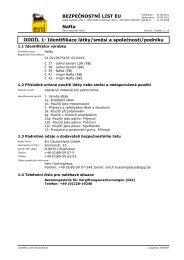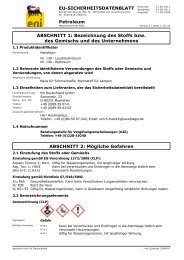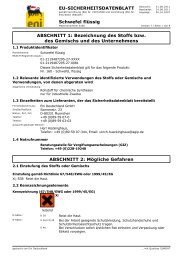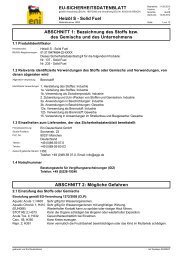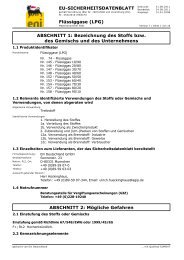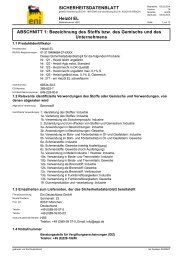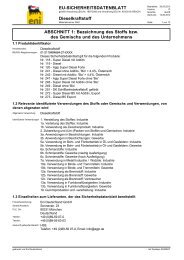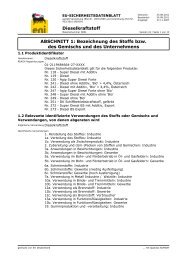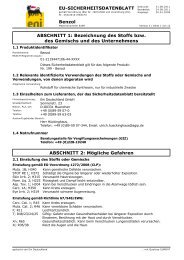EU-SICHERHEITSDATENBLATT CLO (Claryfied Oil) ABSCHNITT 1 ...
EU-SICHERHEITSDATENBLATT CLO (Claryfied Oil) ABSCHNITT 1 ...
EU-SICHERHEITSDATENBLATT CLO (Claryfied Oil) ABSCHNITT 1 ...
Create successful ePaper yourself
Turn your PDF publications into a flip-book with our unique Google optimized e-Paper software.
Heavy Fuel <strong>Oil</strong> Componentsemissions occur E54.CS3 Material transfers Ensure material transfers are under containment or extract ventilationE66 Avoid carrying out activities involving exposure for more than 15minutes OC26. Limit the substance content in the product to 1 % OC16.Wear chemically resistant gloves (tested to EN374) in combination withintensive management supervision controls PPE18.CS36 Laboratory activities. Handle within a fume cupboard or implement suitable equivalent methodsCS39 Equipment cleaningand maintenanceCS67 Storage.to minimise exposure. E12.Drain down and flush system prior to equipment break-in or maintenanceE55 Retain drain down in sealed storage pending disposal or forsubsequent recycle ENVT4. Deal with spills immediately. C&H13. Avoidcarrying out activities involving exposure for more than 15 minutes OC26.Limit the substance content in the product to 1 % OC16. Wear chemicallyresistant gloves (tested to EN374) in combination with intensivemanagement supervision controls PPE18. Retain drain downs in sealedstorage pending disposal or for subsequent recycle ENVT4.Wear chemically resistant gloves (tested to EN374) in combination with‘basic’ employee training PPE16. Store substance within a closed system.E84Additional information on the basis for the allocation of the identified OCs and RMMs iscontained in Appendices 2 to 3Section 2.2 Control of environmental exposureProduct characteristicsSubstance is complex UVCB [PrC3]. Predominantly hydrophobic [PrC4a].Amounts usedFraction of <strong>EU</strong> tonnage used in region 0.1Regional use tonnage (tonnes/year) 1.0e2Fraction of Regional tonnage used locally5.0e-4Annual site tonnage (tonnes/year)5.0e-2Maximum daily site tonnage (kg/day)1.4e-1Frequency and duration of useContinuous release [FD2].Emission days (days/year) 365Environmental factors not influenced by risk managementLocal freshwater dilution factor 10Local marine water dilution factor 100Other given operational conditions affecting environmental exposureRelease fraction to air from wide dispersive use (regional only) 0.98Release fraction to wastewater from wide dispersive use 0.01Release fraction to soil from wide dispersive use (regional only) 0.01Technical conditions and measures at process level (source) to prevent releaseCommon practices vary across sites thus conservative process release estimates used [TCS1].Technical onsite conditions and measures to reduce or limit discharges, air emissions andreleases to soilRisk from environmental exposure is driven by humans via indirect exposure [TCR1j].No wastewater treatment required [TCR6].Treat air emission to provide a typical removal efficiency of (%) N/ATreat onsite wastewater (prior to receiving water discharge) to provide 0the required removal efficiency (%)If discharging to domestic sewage treatment plant, provide the required 0onsite wastewater removal efficiency of (%)Organisation measures to prevent/limit release from siteDo not apply industrial sludge to natural soils [OMS2]. Sludge should be incinerated, contained or2010-08-10 CSR 138




